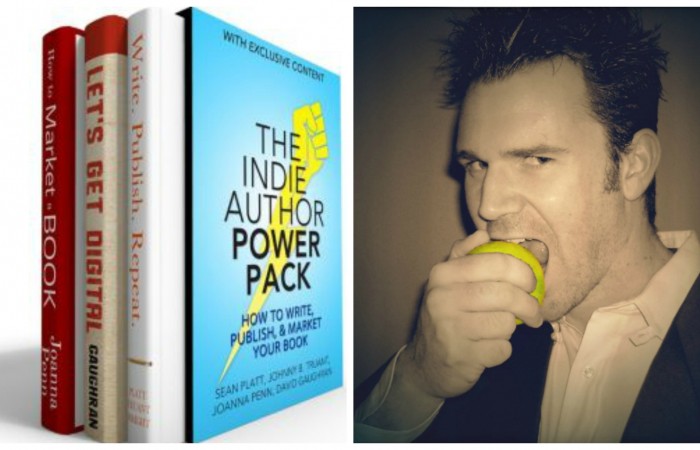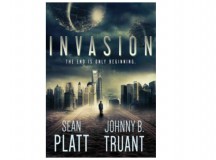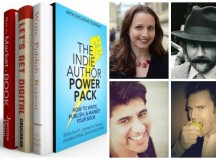
 Did you want to work on your writing in 2014? The good news is that there are still two months in the year AND we’ve got just the kickstart you need: a week-long indie writing and publishing bootcamp from the authors of the newly release The Indie Author Power Pack box set. This tip-packed three-book package is now just $.99 for a limited time. Each day this week, we’ll feature writing, marketing and digital publishing guest posts from its authors and Indie publishing pros: Joanna Penn, Johnny B Truant, Sean Platt, David Graughan. Ready for Day 1?
Did you want to work on your writing in 2014? The good news is that there are still two months in the year AND we’ve got just the kickstart you need: a week-long indie writing and publishing bootcamp from the authors of the newly release The Indie Author Power Pack box set. This tip-packed three-book package is now just $.99 for a limited time. Each day this week, we’ll feature writing, marketing and digital publishing guest posts from its authors and Indie publishing pros: Joanna Penn, Johnny B Truant, Sean Platt, David Graughan. Ready for Day 1?
From Idea to First Draft: 5 Tips for Capturing Ideas and Writing Faster
by Johnny B. Truant
The publishing company I run with my two partners Sterling &Stone has six distinct imprints, and I’ve written books for five of them. In 2013, I published about 1.5 million words — about one and a half times the complete Harry Potter series. When 2014 dawned, I asked my main collaborator Sean Platt if we could slow down. We did … to publish an average of “just” 25,000 words a week.
We’ve mostly stopped talking about Sterling & StonS’s admittedly manic production levels on the Self Publishing Podcast because listeners seemed to feel that they needed to write as fast if we keep talking about how we write fast, but still the questions keep coming:
How can I come up with ideas for things to write about?
Once I have some ideas, how can I write more words in less time?
How can I get out of my own head and just get the story out?
How can I stop getting blocked, and keep moving through the rough spots?
So here, to answer some of those most troubling of questions, are five of my best tips on farming great ideas and then writing through the sludge, to give yourself more raw material to mold and shape at the end of the day.
TIP #1: Steal ideas from real life
My first book was almost autobiographical. It was the purest distillation of the maxim “write what you know” that I could possibly imagine, and followed a character who was basically “me” through a fictionalized version of some highly ridiculous (and illegal) shenanigans at a place where I used to work. At the time, doing that made sense. But today, I don’t think that “writing about you” is the best way to harvest ideas from life. You need to farm smaller ideas that will accent your story, not things that flat-out become your story. There’s a pretty big difference.
As an example, our sci-fi serial The Beam is about the evolution of our society after another 85 years of hyperconnectivity, and the political and societal machinations that occur as a result. There is no “me” in that story, but there is a ton of biology (as Xenia Labs develops bio-interfacing “add-ons” that talk to the Beam network) and philosophy (as scientists attempt to reconcile disembodied consciousnesses with the reality of physical bodies). I have bachelor’s degrees in both disciplines, and salt my work heavily with both. There’s also a character in the second season of The Beam based on a joke with my kids, endless in-references between my co-writer Sean and me, and scenes that occur to characters that I’ve actually lived through myself (albeit with fewer nanobots around).
TIP #2: Never begin with a blank page
I used to be a pure “pantser,” writing each day by the seat of my pants. As a result, my first book took me 12 years to complete. When I learned to use what we call “story beats” (thanks largely to co-writing with Sean), that’s when I had that 1.5 million-word year and will hit another 1.5 million this year. Having some idea about where I wanted the story to end up made all the difference.
“Story beats” are my way of beginning each writing day with a decent idea about what will happen next in the story. They’re sort of an in-advance summary, and far less restrictive than a formal outline, which would turn me into a full-on “plotter.” But beats let me have my cake and eat it too — the benefits of plotting while still pantsing day to day — because beats are just signposts. They’re key points I’ll want to hit to get the story where I need it to go, along with an idea of how that might happen. But I can deviate from beats, and always do. (That’s where the real storytelling magic happens, by the way.)
No matter what I’m writing — and this applies to fiction and nonfiction, novels and blog posts — I always am either handed a prompt of some sort or take the time to wireframe one for myself before starting. Even this blog post was wireframed first. If you can discipline yourself to take the time up front needed to get an idea of what you’ll be writing (to make your page or screen “not blank” before you begin), you’ll instantly find yourself moving faster because you have a goal in mind.
TIP #3: Know your characters
Sean, who does most of the “beating” and world-building in our working partnership, is a big fan of cinema. As such, he’s taken a cue from filmmaking and now “casts” our novels — basically, choosing the actors who’d play our characters in a movie.
Casting is part of what we call “Beats 2.0” but you don’t need to drink the entirety of the cinematographic Kool-Aid to get a feel for what we’re trying to do with it. We want to know our people, because in all of our work, it’s the characters who drive the story. We don’t believe in architected plots; we prefer to have an idea of what might happen but always defer to the characters’ actions and desires. And that means taking time up front, when “beating out” the plot, to figure out who they are, in detail: a bio, a physical description, any relevant relationships with the other characters (and emotions surrounding them), a set of motivations, significant backstory events… the works.
There have been so many times when, in writing a rough draft, a character has steered me in an unanticipated direction. There have been many, many times where characters — not me, as the writer, in any true sense — have talked their way out of tricky situations or resolved plot problems without me having to put in much effort at all. That’s the power of solid characters. That is how you keep moving quickly … because you’re barely even steering the ship; you’re pretty much just writing down whatever the characters do as it happens.
TIP #4: Feel the action and feel the emotion
Of these five tips, this one is the trickiest to describe. It’s possible this may only be experienceable by doing, and that true facility with it may only come from practice. I’m not sure.
But in concept, what I mean here is allowing yourself to dip into a “writer’s fugue” and wallowing in whatever you find there. When I’m writing action, I embrace the fast pace of the scene and allow my heart to triphammer as I watch the scene unfold — with my fingers struggling to keep up. When I’m writing a scene that hits my emotional trigger points (like the inevitable passage of time and the bittersweet nature of recollection, which gets me every time), I let myself be sad. The more you can sink deep into your work, the more facility you’ll have in writing and the less likely you’ll be to get stuck.
One thing I’ve found helps deepen this lately for me is having a “soundtrack” for each book, then listening to that same album every day while writing the first draft. For our young adult steampunk novel The Dream Engine, I listened to the soundtrack to the steampunk movie Sucker Punch. For our upcoming literary mindbender Axis of Aaron, which uses the Oasis album (What’s the Story) Morning Glory as a device, I listened to that album on repeat. Standard music has a way of deepening the trench, immersing me in the feeling of the book’s flow.
TIP #5 Remember that “writing is rewriting”
My 10-year-old son isn’t going to write a novel anytime soon. Do you know why? Because he’ll never be able to write his second sentence until the first sentence is perfect enough to be cast in stone.
Too many writers worry about their final draft — hardbound, perhaps, probably cased in leather and set on a university dean’s bookshelf — while they’re still working on the first. You can’t do that if you expect to move at a decent pace. The expression goes, “Give yourself permission to suck,” and that’s what you have to do. You have to be able to see something fly by on your screen while you’re working on your raw draft and say, “That’s terrible. And I’m going to keep moving anyway.”
Once you’ve gotten through all of your “terrible” copy full of hollow characters and unbelievable, impractical events that no sensible reader would ever believe, you have a lump of clay that may still require significant molding. But here’s the thing: You have a lump of clay. Fail to finish that first draft by forgetting that your truest job in storytelling isn’t writing so much as rewriting to make it better and you’ll have nothing at all.
If you want to produce quickly, try to keep in mind that the first draft doesn’t have to be good. It just has to get the story out enough to give you something to work with. You’ll move faster in the rough, and you’ll see more words make it to that final draft.
Write. Publish. Repeat.
My partner Sean and I believe so firmly in the idea of writing fast — but not sloppily; never sloppily — in order to grow our writing business that we named a book after it. First you write. Then you publish. And then (and here’s the part where the ability to produce quickly is a huge asset), you repeat.
Write. Publish. Repeat: The No-Luck-Required Guide to Self-Publishing Success is just one of three top-rated self-publishing guides available right now for only 99 cents in The Indie Author Power Pack: How to Write, Publish, and Market Your Book.











Thanks, Johnny. Some great tips that have helped reinforce some of my own beliefs.
I think #4 is so important, but hard to achieve for novice writers. I struggle with being pulled out of the emotion by the physical task of typing. Sometimes, to overcome that on critical scenes, I use a speech-to-text, which allows me to stay immersed in the feelings. I guess it will get easier with time.